NASA mapping data educates computers for safe landings
MIT boffins reckon they can use old-school artificial intelligence to do much of the grunt work in the tricky task of picking suitable landing spots for spacecraft.
in a paper for the Earth and Space Science journal, the US-based researchers described a tool that can automatically examine maps of the Martian surface, and say whether the different locations would make good landing sites. The software uses fuzzy logic algorithms, which were introduced in the 1960s and were rather trendy in the 1990s.
“Traditionally this idea comes from mathematics, where instead of saying an element belongs to a set, yes or no, fuzzy logic says it belongs with a certain probability, thus reflecting incomplete or imprecise information,” Victor Pankratius, coauthor of the paper and a research scientist and principal investigator in NASA and National Science Foundation projects at MIT, explained this week.
NASA and other space agencies have slowly amassed troves of geographical data on Mars. The researchers reckon that NASA has over 100 Terabits from all the different orbiters, landers, and rovers sent to the Red Planet, but it’s still not enough to completely determine the exact conditions on the ground there.
The program splits an image of a particular region into cells, each measuring about 3 square kilometers. Fuzzy logic is used to spit out a number from 1 to 0. If the score is closer to one a lighter colour is placed on the cell representing that the surface is fairly level. If it is closer to zero, a darker colour is added and it shows that the slope is steep. By shading these cells, it creates what resembles a heat map depicting the best places to land a rover.
Another algorithm is known as the fast marching method, it calculates different paths across the Martian surface that a rover can take once it has landed. “If you are somewhere on Mars and you get this processed map, you can ask, ‘From here, how fast can I go to any point in my surroundings?‘ And this algorithm will tell you,” Pankratius said.
The program picked out different possible landing sites that have been previously considered by planning committees, and new ones that weren’t suggested before. There are other, trickier, factors that are important to consider such as the speed of the rover, and the amount of dust at a particular site, and humans are needed to make a decision on that.
The researchers hope to collect more data to improve the program. „This is never going to replace the actual committee, but it can make things much more efficient, because you can play with different scenarios while you’re talking,“ Pankratius concluded. ®
Sponsored: Following Bottomline’s journey to the Hybrid Cloud






